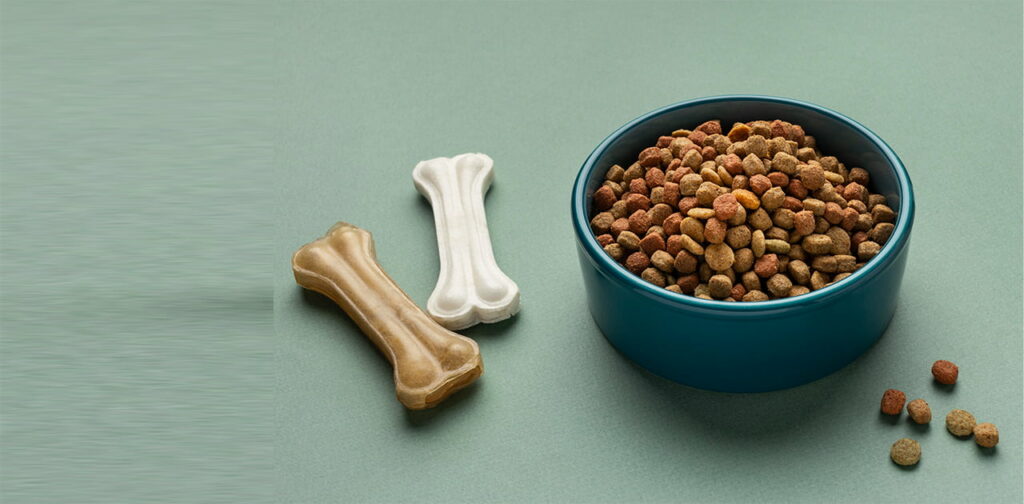Deciding when to transition your puppy to adult dog food is an important aspect of responsible pet care. As the journey from puppyhood to adulthood is unique for every dog, understanding the factors influencing this switch becomes crucial.
In this article, we will discuss when to switch to adult dog food, your dog’s nutritional needs, and practical steps to ensure a seamless transition, ultimately contributing to your canine companion’s lasting health and happiness.

When Should You Switch from Puppy to Adult Dog Food?
Generally, the switch is required to happen when the puppy is 12 months old. But this cannot be specific as puppies come from different breads and sizes. The proper timing of switching from puppy to adult food depends on the size, breed, and individual growth rate of your dog.
To discuss exactly when to switch to adult dog food, we can divide them into 3 categories. First, small breeds like Chihuahua, and Pomeranian can easily switch to adult food around 9-12 months. Secondly, medium breeds like Beagle and Cocker Spaniel can do it around 12 months. Smaller and medium breads can make the transition earlier.
Finally, large breeds like Labrador Retrievers, and Golden Retrievers may take 12-18 months to switch. Furthermore, the weight and health of your dog will also affect your dog’s dietary needs.
Understanding the Difference Between Puppy and Adult Dog Food
Puppy food has higher levels of protein, fat, caloric density, calcium and phosphorus, vitamins, and minerals. Puppy food especially focuses on rapid growth development, the requirements for their energetic nature. Adult dog foods focus on body structure maintenance, weight maintenance, and lower caloric density to match with their lower energy requirements.
Puppies and dogs also have different specific needs. Puppies have rapid growth and development requirements, small and frequent meals, and DHA brain development. Puppy foods are made especially to meet these specific needs. In contrast, adult dogs need more maintenance, weight management, joint support, common nutritional elements, and a balanced mixture of nutrients. Therefore, it is important to know when to switch to adult dog food.
Factors to Consider When Switching to Adult Dog Food
You must consider factors like breed size, activity level, post spaying (for females) or neutering (for males) state before shifting from puppy food to adult food to ensure your dog’s wellbeing.
Breed Size
Due to smaller physical structure, faster metabolism, active lifestyle, and higher energy needs, smaller dogs often require foods with higher caloric density, higher protein content, and smaller kibble sizes. In contrast, large breeds grow at a slower rate and require more joint support and bone development. If you end up feeding excessive food or nutrients it can cause rapid growth resulting in skeletal issues and many other health issues.
- For small-breed dogs, you can look for formulas or pet foods specifically made for small breeds. It is also important to include essential nutrients like DHA for cognitive development.
- For medium-breed dogs, you should pick a formula or dog food with joint-supporting ingredients and balanced nutrients.
- For large breed dogs, you can look for formulas or pet foods with controlled levels of calcium and phosphorus, glucosamine, and chondroitin.
Activity Level
Active dogs burn more calories, protein, fat content, and hydration as they engage in frequent and intense physical activities. Sedentary dogs do not require as many nutrients as they have a lower energy expenditure. Overfeeding or underfeeding often results in obesity, weight loss, weakness, etc.
Spaying or Neutering
Your dog’s metabolism and nutritional needs can be impacted by spaying (for females) or neutering (for males). After the procedure, many dogs experience weight gain. To prevent this you must reduce caloric intake and maintain a balance of proteins, fats, and carbohydrates in your dog’s dietary plans. You should also visit the veterinarian to check up on the health and condition of your dog.
Switching Too Early or Too Late
Switching too early can result in Nutritional deficiency growth issues and digestive issues for the puppy. Likewise, you cannot also take the risk of switching too late because it may cause excess calories, imbalanced nutrition, and a higher cost of food.
It is advisable that you meet with a well-experienced veterinarian as they can provide personalized advice, preventive measures, nutritional assessments, and weight management strategies.
How to Pick the Right Adult Dog Food
How to Pick the Right Adult Dog Food
It is important to pick the right brand and type of dog food with proper nutrients. Lets discuss how you can choose the right one for your dog’s unique needs.
a. Choosing a Brand
Your journey of choosing the right brand for your fur buddy can be confusing. But if you do some research before buying and feeding, you can easily figure it out by yourself.
Stary by researching the most reputable brands, check if they are following the regulatory compliances, check the ingredient lists, and avoid products with excessive additives, preservatives, or artificial colors, consider your os specific needs and if any brand specializes in the area, avoid brands who makes insubstantial claims, check for customer reviews from the people you know and online.
It is important to consult your veterinarian to ensure you have clear ideas about the necessities of your dog.
b. Dry Food vs. Wet Food
While dry foods may be convenient, good for dental health, and cost-effective, they also have the issue of being less palatable and moisture content. However, wet dog food has richer palatability, moisture content, and better digestibility. It may not be as cost-effective and good for dental health.
As you can see both types of food have their benefits and setbacks. We advise you to try combination feeding based on your dog’s age and health.
C. Nutritional Requirements
Different dogs need different levels of nutrition and hydration. The nutritional requirements of dog foods are protein, fat, carbohydrates, vitamins, minerals, water, fibre, and antioxidants. You must choose the right balance of nutrients as each of them has different roles to play in your dog’s health.
For example, protein helps in muscle development, fat helps in maintaining healthy skin and coat, carbohydrates work as the main source of energy, and vitamins help in metabolic processes and immune function.

How to Transition Your Puppy to Adult Dog Food
Since now you know when to switch to adult dog food let’s discuss how you can make the transition. To avoid digestive issues and ensure the complete well-being of your dog you have to switch to adult dog food gradually. Follow these easy and simple steps to make the transition even smoother.
- Step 1: Consult with your veterinarian
- Step 2: Research and select a reputable brand of adult dog food
- Step 3: Use the adult food as a treat to see how your dog responds.
- Step 4: Start gradually with a ratio of 75% puppy food to 25% adult food
- Step 5: Monitor your dog’s overall behavior and digestive changes
- Step 6: Adjust the food ratio by increasing portions of adult food with time.
- Step 7: Complete the transition
Tips to Monitor the Process
- It is vital to monitor the process to make sure your dog is safe and healthy. Proper monitoring will ensure
- Observe stool quality. Loose stools indicate rapid transition, you may need to slow down the process and give your dog more time.
- Look out for allergies or sensitivity. In case of skin issues, itching, or gastrointestinal problems you must consult with your vet and follow their guidance.
- Regularly consult with your vet to ensure a safe and smooth transition.
Conclusion
In conclusion, the journey from puppy to adult dog food is a vital phase in your furry friend’s life. Navigating this transition with care, considering individual factors such as breed size, activity level, and health. This ensures the optimal well-being of your canine companion.
Knowing when to switch to adult dog food and how to do it can make you more confident with the process. Remember, a balanced and informed approach, coupled with the guidance of a veterinarian, shapes the way for a lifetime of proper nutrition and joy for your beloved pet.





